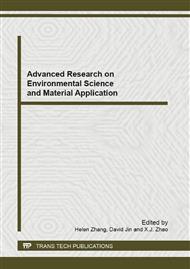p.161
p.166
p.170
p.174
p.178
p.182
p.186
p.190
p.194
Study of Deashing and Activation on the Coke Fines and Semi-Cokes Based on Properties of Composite Materials
Abstract:
Coke fines and semi-cokes have high ash content, low specific surface area and pore volume. In order to increase the properties of the sample and make the activated composite materials, it must be deashed and activated. In this research, the deashing experiment of the raw materials by different concentration of HNO3 and KOH was tested, then the material was activated in high temperature steam. From the FTIR test, we can acquire the content of the surface functional groups, such as carboxyl and hydroxyl. The specific surface area, pore size, volume of the material were determinated by using the N2 isothermal adsorption. From the experiments of acid and alkali treatment, we can conclude that the optimal technological condition of the material: the concentration 20% of alkali and acid treatment processing. The ash content is decreased to 8%. The acid functional groups increased rapidly after HNO3 treatment. The activated coke fines have mainly mesopores and its proportion of microspore is low. The specific surface area of the activated material reached 80m2/g and increased about 5 times than that of raw materials.
Info:
Periodical:
Pages:
178-181
Citation:
Online since:
November 2012
Authors:
Price:
Сopyright:
© 2012 Trans Tech Publications Ltd. All Rights Reserved
Share:
Citation:


